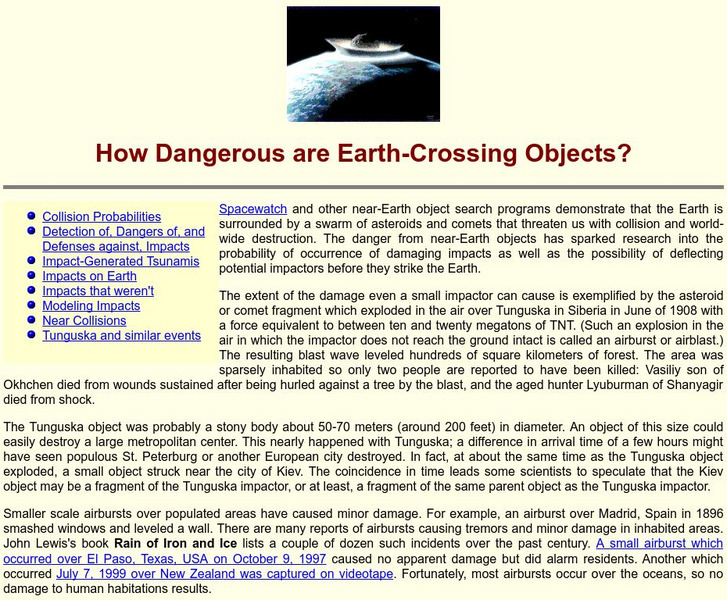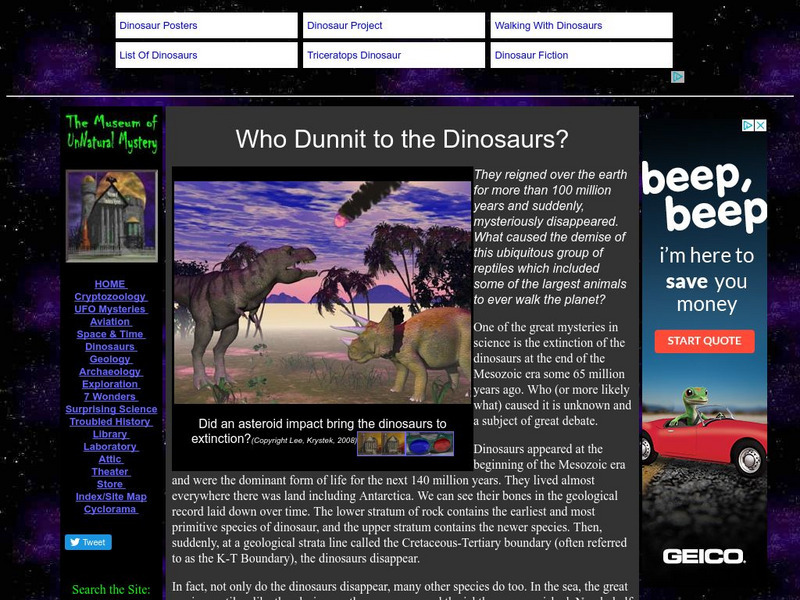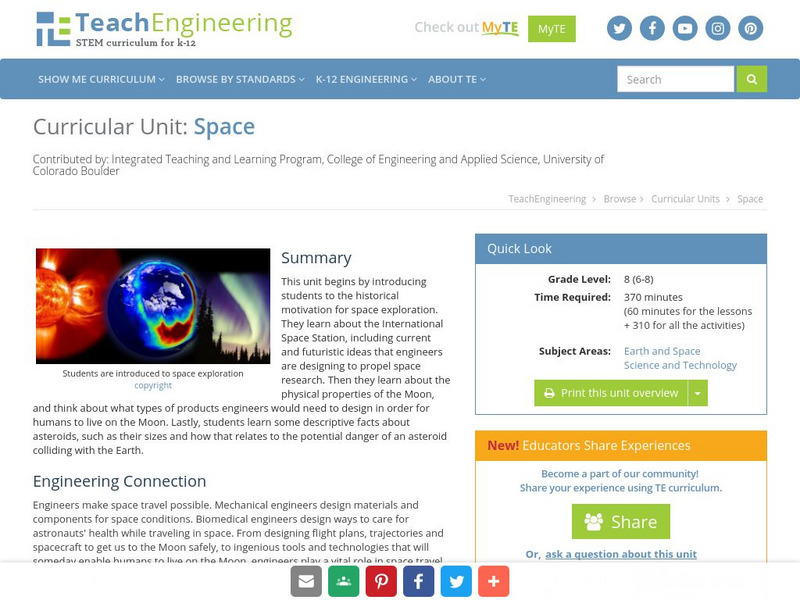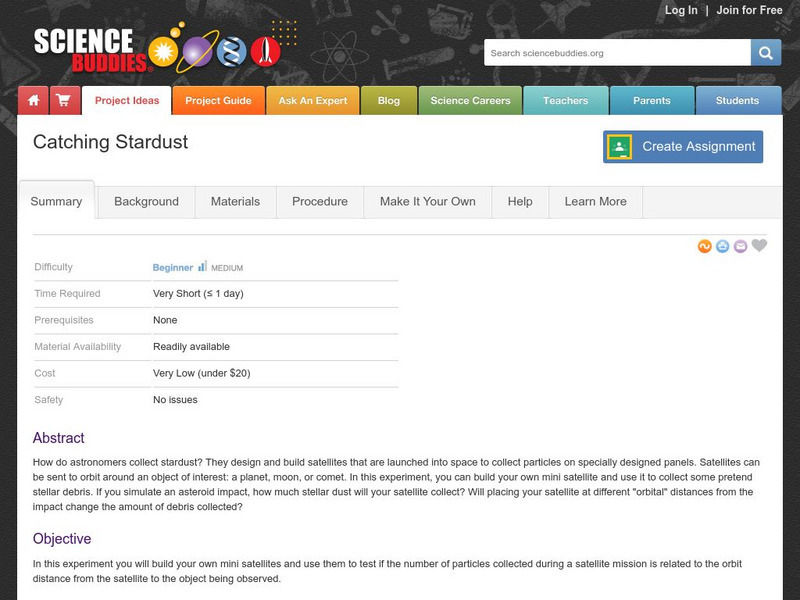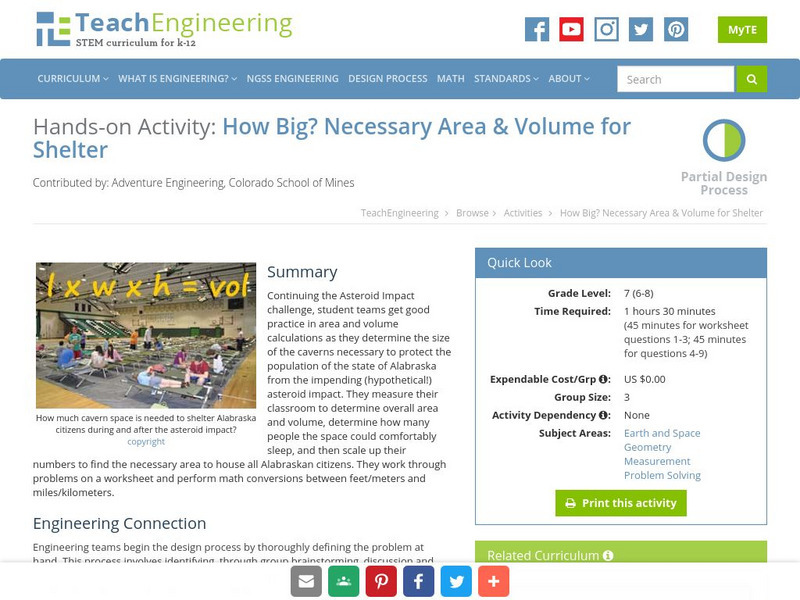Hi, what do you want to do?
Other
Pibs: How Dangerous Are Earth Crossing Objects?
This resource page discusses how close Earth is to a collision with other objects. This page gives helpful information about comets and asteroids as well links to other resources on the topic.
Other
Who Dunnit to the Dinosaurs?
"One of the great mysteries in science is the extinction of the dinosaurs at the end of the Mesozoic Era some 65 million years ago. Who (or more likely what) caused it is unknown and a subject of great debate." Many theories are touched...
Ducksters
Ducksters: Astronomy for Kids: Glossary and Terms
Kids learn about the glossary and terms for the science of astronomy including words and definitions such as asteroid, comet, meteoroid, galaxy, eclipse, etc.
Curated OER
Near Earth Asteroid Rendezvous (Near) Discovery Mission
This is the homepage of the spacecraft NEAR Shoemaker, the first to conduct a long-term, close-up study of an asteroid. The site contains information on the asteroid 453 Eros, including mass, structure, geology, composition, and gravity.
Curated OER
Deep Space 1 Rendezvous'd With an Asteroid
This site from the National Aeronautics and Space Administration provides a fun project on rockets. "Nothing in space stands still. Everything either orbits around something else, or moves toward or away from something else. So how do...
PBS
Pbs: Nova: Doomsday Asteroid: Comets 101
An introduction to comets, including information on their composition, origin, and importance.
PBS
Nova: Doomsday Asteroid Hale Bopp & Hyakutake
NOVA provides a report on comet Hale-Bopp and comet Hyakutake. Content includes discovery and observational information.
Other
Sky Server: Scavenger Hunt
In this site, from the SkyServer of the Sloan Digital Sky Survey users hunt for stars, galaxies, quasars, asteroids and meteors. Learn what they look like and how to find them.
Other
Kid Power: Astronomy for Kids
Young children can find facts about the Solar System, the Sun, meteorites, stars, galaxies, planets, our moon, comets, asteroids, and space exploration. Pages offer clear photos and bullet-point information, which is easy to read and...
ClassFlow
Class Flow: Asteriods, Comets and Meteriods
[Free Registration/Login Required] In this flipchart students will learn basic facts about Asteroids, Comets and Meteoroids.
Georgia Department of Education
Ga Virtual Learning: Our Solar System
This interactive tutorial will take students on a tour of our solar system. Students begin near the Sun with the really hot planets of Mercury and Venus. They will learn about Mars, probably the first planet that humans will visit. Next...
TeachEngineering
Teach Engineering: Space
In this unit, students first are introduced to the historical motivation for space exploration. They learn about the International Space Station and are introduced to new and futuristic ideas that space engineers are currently working on...
PBS
Pbs Learning Media: Mammals Get Their Chance
In this video segment adapted from NOVA, animations of an asteroid hitting Earth are used to illustrate this widely accepted theory of dinosaur extinction and the resulting conditions that favored mammals.
Science Buddies
Science Buddies: Catching Stardust
How do astronomers collect stardust? They design and build satellites that are launched into space to collect particles on specially designed panels. Satellites can be sent to orbit around an object of interest: a planet, moon, or comet....
TeachEngineering
Teach Engineering: How Big?
Students teams determine the size of the caverns necessary to house the population of the state of Alabraska from the impending asteroid impact. They measure their classroom to determine area and volume, determine how many people the...
TeachEngineering
Teach Engineering: Linear Equations Game
Students groups act as aerospace engineering teams competing to create linear equations to guide space shuttles safely through obstacles generated by a modeling game in level-based rounds. Each round provides a different configuration of...
Other
Permanent: Lunar Materials: Other Minerals
This site provides information on minerals found on the moon. (PERMANENT stands for Projects to Employ Resources of the Moon and Asteroids Near Earth in the Near Term.)
BBC
Bb Ci Space: Solar System
Take a journey through the solar system with this interactive guide. Includes planetary history, "travel information," "tourist highlights," and video clips. Games and quizzes include a Solar System jigsaw that prompts the student to...
University of Cambridge
University of Cambridge: Nrich: Game Asteroid Blast
Use this game to improve your addition, subtraction, multiplication, and division basic facts. Practice all these skills and have fun at the same time! There is a "Get Printable Page," link at the top to print out the materials you need.
Massachusetts Institute of Technology
Mit: Open Course Ware: Earth, Atmospheric and Planetary Sciences: Solar System
A university-level course that looks at the structure of the solar system, the sun, the planets, and other bodies in space. Includes course readings, assignments, and study notes.
Sheppard Software
Sheppard Software: Starfish
This site gives an in-depth description of a starfish, including its behavior, appearance, reproduction, and classification. The site includes photos and illustrations and an interactive quiz to test your understanding.
PBS
Pbs: Tour the Solar System
Click on each space object to discover facts and other information about the many space objects that make up the solar system.
Georgia Department of Education
Ga Virtual Learning: Astronomy: The Earth
In this interactive tutorial students will learn what causes the seasons, diurnal cycles and how the constellations move through the sky. Learn we are able to see other planets and how astronomical events affected life on the Earth.
Other popular searches
- Asteroids Comets and Meteors
- Asteroid Belt
- Comets and Asteroids
- Comets Meteors Asteroids
- Comets Asteroids
- Meteors and Asteroids
- Comets Asteroids Meteoroids
- Comet and Asteroid
- Comets, Meteors, Asteroids
- Comets,meteoroids, Asteroids
- Moons, Comets, Asteroids
- Asteroid Impacts





